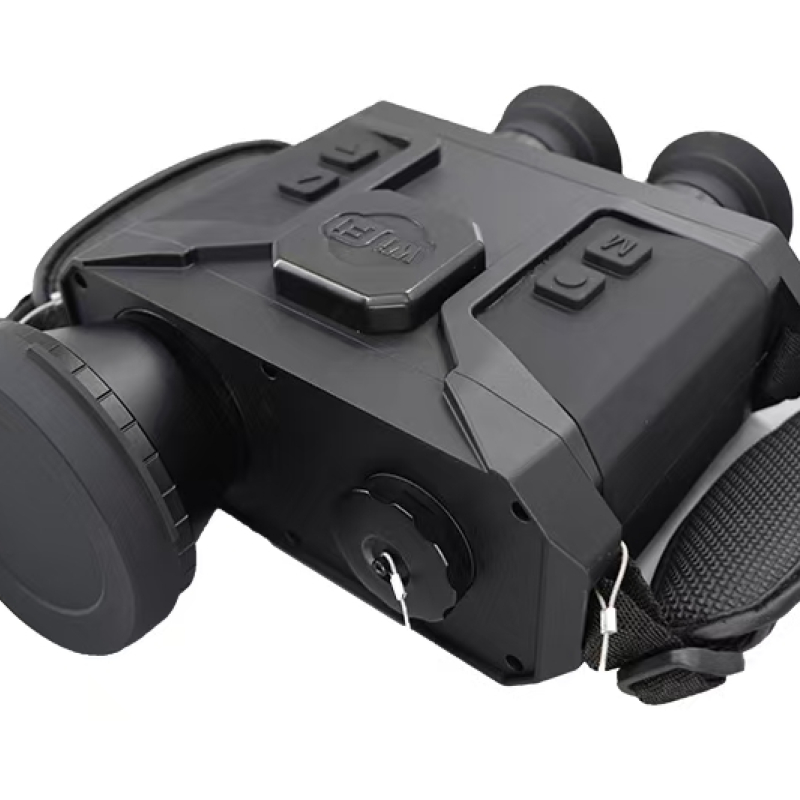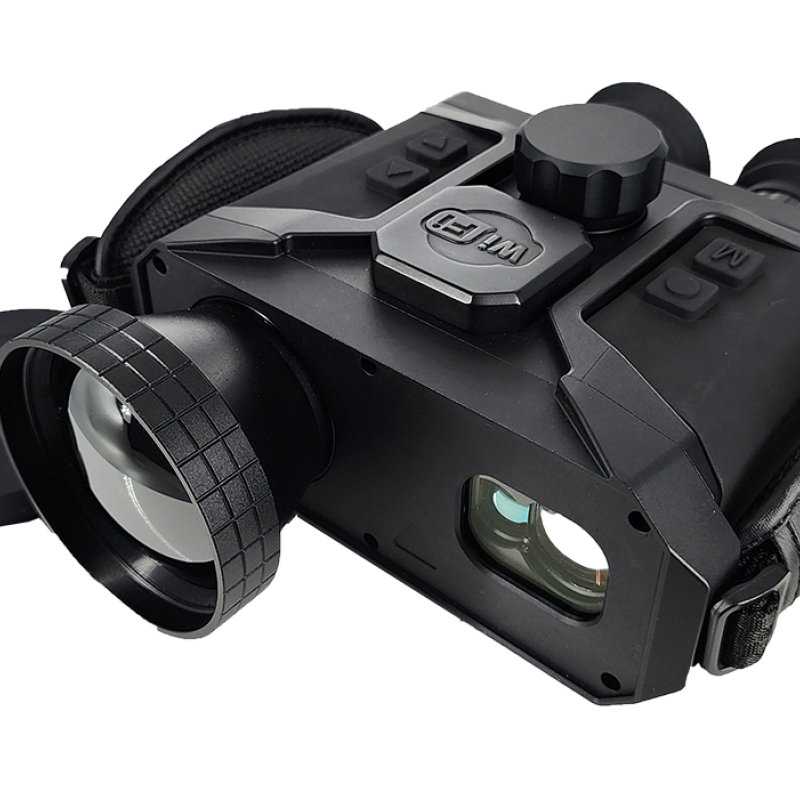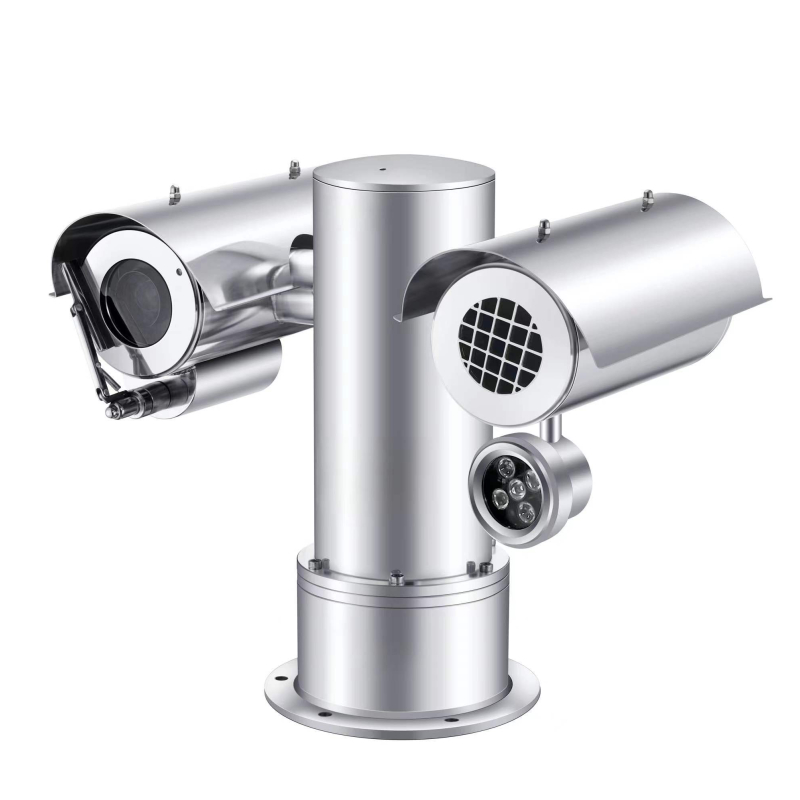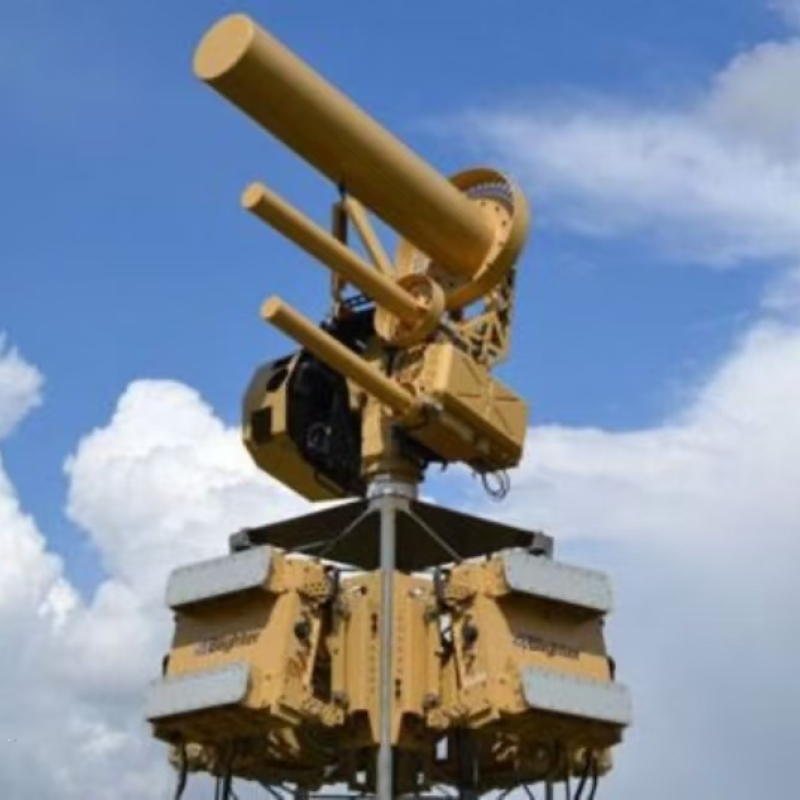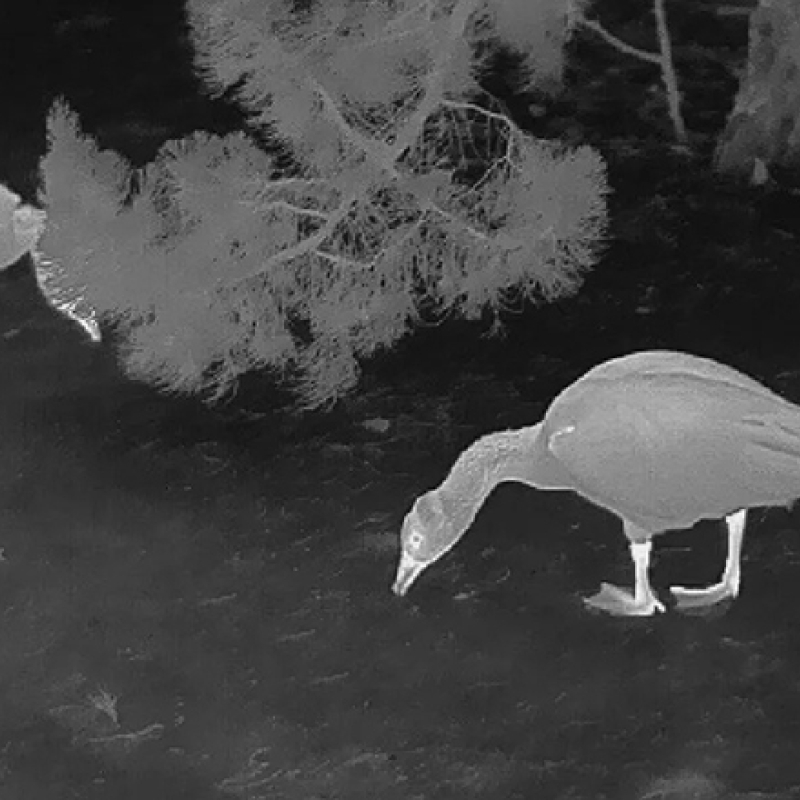The JV-MFB375-5006 utilizes infrared technology to capture light, including infrared light that is invisible to the human eye, so it can work effectively in low-light or even no-light environments.Feature➢NETD:<50mK@300k F#1.0➢ Detector Type:UnCooled VOx FPA➢Focal Length:f= 85mm F1.0➢FOV:4.4°×3.3°➢ Distance:Detection 2.0km Recognition 0.6km(Human);Detection 7.0km Recognition 2.0km(Vehicle) Technical parameterParameters / ModelJV-MFB385-5007Detector TypeUnCooled VOx FPAResolution384*288@17μmSpectral Range8~14μmFrame Rate50HzNETD<50mK@300k F#1.0Display1024×768 0.39"
Contact Now
JV-MFB685-5010 utilizes infrared technology to capture light, including infrared rays that are invisible to the human eye, so it can work properly in low-light or even no-light environments.
Contact Now
The system provides silent operation, advanced target positioning, and image storage capabilities, and can work well in various battlefield conditions.
Contact Now
JV-MFB675-5007 includes laser rangefinding to be able to measure targets at long distances.
Contact Now
JV-MFB375-5006 is able to work effectively in low-light or even no-light environments by using infrared technology to capture light, including infrared light, which is invisible to the human eye.Feature➢NETD:<50mK@300k F#1.0➢Detector Type:UnCooled VOx FPA➢ Focal Length:f= 75mm F1.0➢FOV:4.9°×3.7°➢ Distance:Detection 1.8km Recognition 0.5km(Human);Detection 7.0km Recognition 2.0km(Vehicle) Technical parameterParameters / ModelJV-MFB375-5006Detector TypeUnCooled VOx FPAResolution384*288@17μmSpectral Range8~14μmFrame Rate50HzNETD<50mK@300k F#1.0Display1024×768 0.39&qu
Contact Now
JV-MFB650-5006 makes use of infrared technological know-how to seize light, consisting of infrared mild that is invisible to the human eye, so it can work correctly in low-light or even no-light environments.Feature➢NETD:<50mK@300k F#1.0➢Detector Type:UnCooled VOx FPA➢Focal Length:f= 50mm F1.0➢FOV:8.8°×7.0°➢Distance:Detection 1.8km Recognition 0.5km(Human);Detection 6.0km Recognition 1.8km(Vehicle) Technical parameterParameters / ModelJV-MFB650-5006Detector TypeUnCooled VOx FPAResolution640*512@17μmSpectral Range8~14μmF
Contact Now
JV-MFB675-5012 is a multi-purpose reconnaissance system, advanced hand-held, fully integrated muti-function thermal imager binocular, which allows the user to detect and located target. It can get the coordinates and directions of the targets in day and night with thermal image or day light Camera. It equipped with a latest UN-cooled thermal imager, eye safe laser range finder, integrated GPS/GNSS,digital magnetic compass (DMC) and visible light camera.
Contact Now
With silent operation, advanced targeting and image storage, the system is designed to operate in a wide range of battlefield conditions.Features➢NETD:<50mK@300k F#1.0➢Detector Type:UnCooled VOx FPA➢E-Zoom:1X/2X/4X➢Focal Length:f= 50mm F1.0➢FOV:7.5°×5.6°➢Distance:Detection 1.2km Recognition 0.3km(Human);Detection 4.0km Recognition 1.2km(Vehicle) Technical parametersParameters / ModelJV-MFB375-5006LDetector TypeUnCooled VOx FPAResolution384*288@17μmSpectral Range8~14μmFrame Rate50HzNETD<50mK@300k F#1.0Display1024×768 0.39"OLED X2Image ProcessingBoot Time<6sNoise ReductionDig
Contact Now
Multi-functional infrared binoculars are optical devices that combine night vision capabilities with telescopic vision, and are widely used in night observation, navigation, nature observation, and security. Feature➢NETD:<50mK@300k F#1.0➢Detector Type:UnCooled VOx FPA➢Focal Length:f= 50mm F1.0➢FOV:7.5°×5.6°➢Distance:Detection 1.2km Recognition 0.3km(Human);Detection 4.0km Recognition 1.2km(Vehicle) Technical parameterParameters / ModelJV-MFB350-5004Detector TypeUnCooled VOx FPAResolution384*288@17μmSpectral Range8~14μmFrame Rate50HzNETD<50mK@300k F#1.0Display1024×768 0.39&q
Contact Now
This product outfitted with a modern-day UN-cooled thermal imager, eye secure laser vary finder, built-in GPS,WIFI,digital magnetic compass (DMC) and seen mild camera.
Contact Now
Observation DistancePer person (1.8×0.5 m)Detection3.5 km( Typical climatic conditions)Recognition1.5kmVehicles (2.3×4.7 m)Detection7.5 km( Typical climatic conditions)Recognition4.5 kmTechnical parameterParameters / ModelJV-MFB675-5005Detector TypeUncool-ed VoXArray Size/Resolution640×512Spectral Band8~12μmDetector Pitch12μmFrame Rate50Hz(PAL)PolarityWhite hot/Black hot(pseudo-color)NETD≤40mK@25℃,F#1.0Contrast/BrightnessAuto/ManualImage ProcessingImage DenoiseDigital filterImage EnhancementDigital Detail EnhancementE-Zoom1~4×Infrared OpticalFocus modeMotorize FocusIR Lensf=75mm, F# 1.0Fi
Contact Now
Feature➢ This product integrates remote human eye safe laser ranging, GPS and high-precision digital electronic compass, which can help users quickly discover and dispose the target. ➢ The system uses advanced image compression algorithm to record real-time images, which can help users to sample and obtain evidence synchronously.➢ The system has excellent waterproof and dust-proof performance, compact structure, light weight, durable, anti-seismic and anti-interference, and can be used in the whole climate environment.
Contact Now
Observation DistanceApplications- Reconnaissance and Surveillance- Target Acquisition and Identification- Battlefield Communication- Intelligence Gathering and AnalysisTechnical parameterParameters / ModelJV-MFB675Detector TypeUncooled VoXArray Size/Resolution640×512Spectral Band8~12μmDetector Pitch12μmFrame Rate50Hz(PAL)PolarityWhite hot/Black hot(pseudo-color)NETD≤40mK@25℃,F#1.0Contrast/BrightnessAuto/ManualInfrared OpticalFocus modeMotorize FocusIR Lensf=75mm, F# 1.0Field of view5.9°×4.7°E-zoom1x~4xMicro Display2×1024x768 OLEDEyepiece Magnification15×GPS /GNNSAccuracyCEP< 2mWIFIDist
Contact Now
The resolution of this product is 640* 512@17 μ m. It is equipped with the latest United Nations cooled thermal imaging system, eye safe laser rangefinder, integrated GPS, WIFI, digital magnetic compass (DMC), and visible light camera.
Contact Now
This product’s resolution is 384*288@17μm.It equipped with a latest UN-cooled thermal imager, eye safe laser range finder, integrated GPS,WIFI,digital magnetic compass (DMC) and visible light camera.
Contact Now
FeatureCompliance and Certification:Each unit undergoes rigorous testing to ensure compliance with relevant safety standards, providing assurance to users that they are employing a tool that not only enhances operational efficiency but also prioritizes worker safety.Long-lasting Battery Life:Understanding the importance of uninterrupted operation in hazardous areas, these binoculars are powered by high-capacity batteries, ensuring extended usage times between charges.Technical paramaterJV-ETVC4108-2037Thermal imagingTypes of detectorsUncooled infrared focal plane sensorM
Contact Now
Laser rangefinder is widely used in terrain surveying, battlefield surveying, ranging of tanks, aircraft, ships and artillery to the target, measuring the height of clouds, aircraft, missiles and artificial satellites. It is an important technical equipment to improve the accuracy of high tanks, airplanes, ships and artillery.
Contact Now
JV-MFB675-5008 is a day and night time handheld remark instrument,which composed of many superior sensors,sign processing circuits and optical components.
Contact Now
JV-LRFM10 is an intelligent portable monocular laser rangefinder. It is equipped with a low-light camera module, a laser ranging module, a digital electronic compass, a GPS positioning module, a display module, and a central information processing unit. It integrates high-precision single measurement, continuous measurement, multi-target relative measurement, and memory storage functions.
Contact Now
The JV-MFB675-FD/JV-MFB675-FDP features a variety of observation modes, such as night vision, thermal imaging, or high-definition daytime observation, to meet the needs of use in different environments.
Contact Now
Features➢Provide high-definition visible light and mid wave infrared videos and images for the detection area➢Capable of detecting and identifying ground targets➢Support search, tracking, locking, guidance and other working methods➢With character overlay, customization, and display functions➢Equipped with target positioning function, 6km for people and 15km for vehicles➢Equipped with laser ranging function, 2km for people and 8km for vehicles➢Equipped with self checking and fault diagnosis functionsTechnical paramatersParameters / ModelJV-GTV30GDEO SensorWavelength0.4~0.9μmResolution1920*1080F
Contact Now
Features- Small dimension and moderate weight- Class I human eye protection standards- Stable general overall performance and basic to use- Provide customization service- Distance measurement for automobile over 10 km- Developed especially primarily based on 1535nm Er:Glass laserApplicationsConstruction and Engineering: - Verifying the accuracy of construction elements, such as walls, floors, and foundationsLand Surveying and Mapping: - Monitoring changes in land features, such as erosion, landslides, and
Contact Now
FeatureExplosion-Proof Safety:These binoculars are built with one-of-a-kind explosion-proof substances and designs to make sure that no sparks or warmness sources are generated in probably explosive environments,thereby safeguarding each operators and equipment.User-Friendly Interface:Featuring an intuitive user interface and simple operation controls, they allow even non-professionals to quickly become proficient, effectively enhancing work efficiency.Technical paramaterJV-EVC2025Explosion-proof signEx db ⅡC T6 Gb/Ex tb IIIC T80℃ DbProtection levelIP68CameraImage Sensor1/2.8” Progressive
Contact Now

